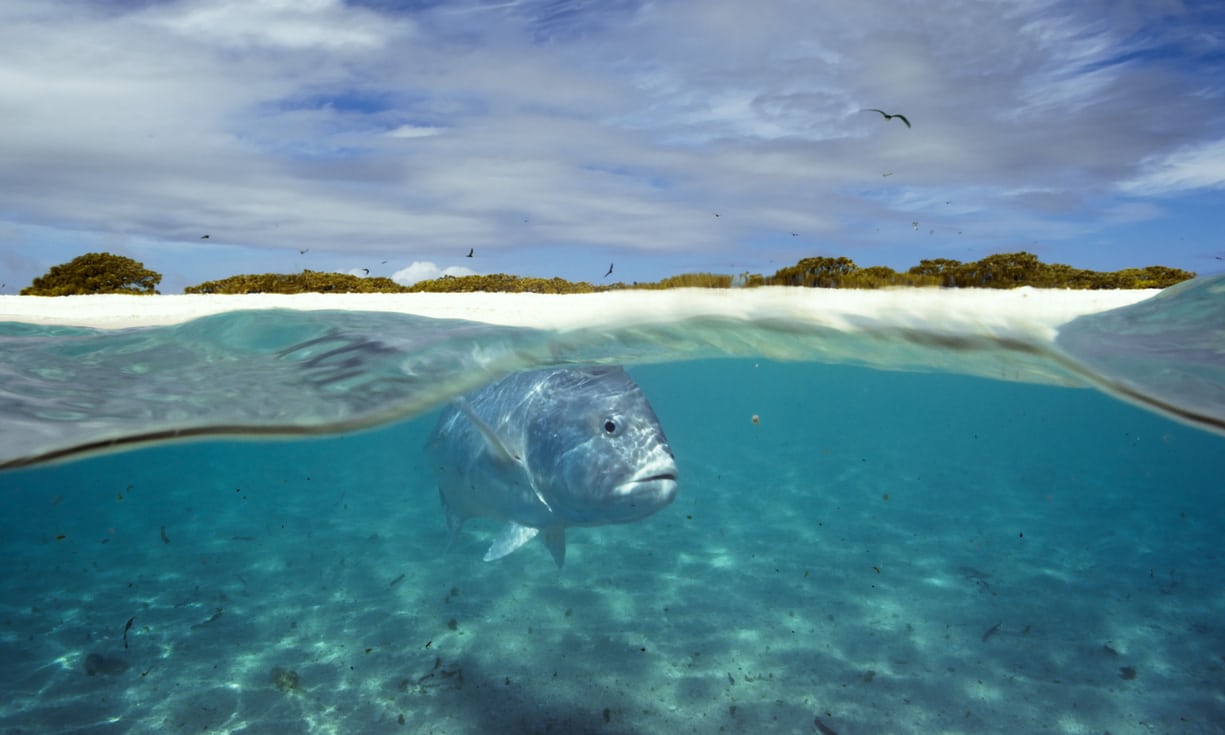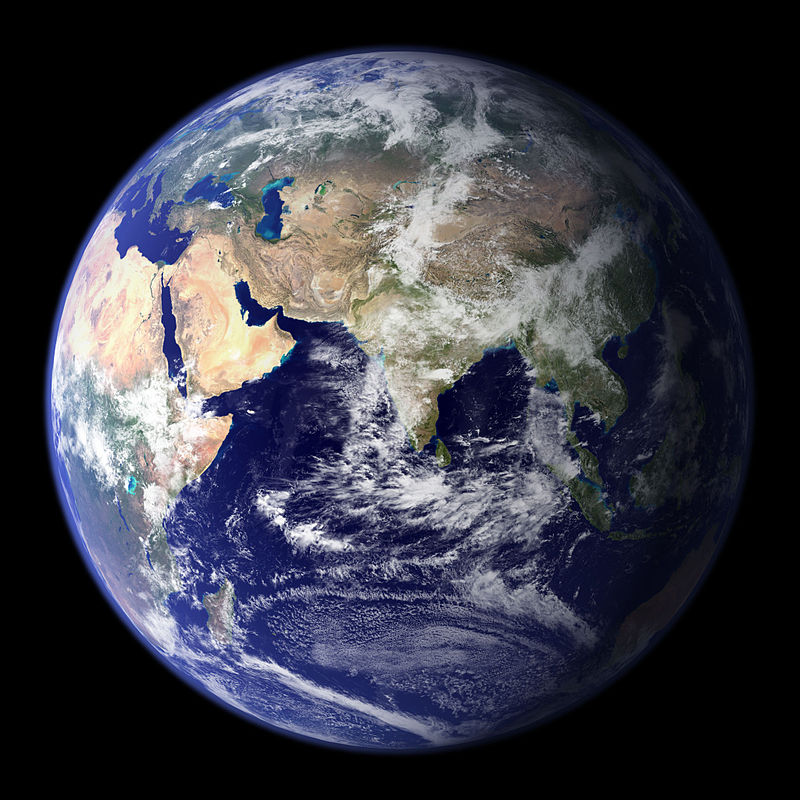
On the basis that ‘Dog bites Man is not news, but Man bites Dog is news’ then I can understand why we saw Giant Trevally fish gobbling up young Sooty Terns. Did you see them? Quite something when a nearly 6-foot fish jumps out of the water to catch a tern in flight. And, above, there’s one looking as though butter wouldn’t melt in its mouth. Not quite as gripping as Racer Snakes and baby Marine Iguanas but almost, almost.
The False Killer Whales and dolphin sequence was fascinating, but rather irritatingly we were left hanging as to what that behaviour was all about. I felt a bit as if I had been tricked into thinking one way, told it was wrong and then left all, well, all at sea I guess.
I liked the Orange-dotted Tuskfish bashing its clam. I liked that a lot.
But, excuse me for being fish-ist, it is a bit more difficult to get emotionally involved with fish, or even mammals that look quite a bit like fish such as whales and dolphins, than it is with cuddly creatures like Lions and Baboons. Or is that just me?
When the tuskfish was bashing its clam, which I liked a lot, I did feel as though it was doing pretty well for a fish but we mammals wouldn’t make quite such a meal of it – or actually, would make it a meal a lot quicker.
In some ways, the scenes of quite incredible waves were some of the best scenes – I could look at them for ages.
I’ll be watching next week. What did you think?

[registration_form]
I found the programme a bit disjointed and I wasn’t sure of the theme. I found the new behaviours fascinating but wonder if we are again focusing on the power of new technology rather than real learning. I find the 10 minute slot at the end showing how we humans struggle to match the subjects irritating! Next week’s programme, looking at the deeps, sounds more interesting.
that last 10 minutes is to make the program an hour long on the BBC, of course when it is sold around the world you need that time for adverts.
Stunning photography and much fascinating behaviour, but was the implication that the Pacific Walrus is threatened strictly correct?
Paul Homewood quotes the U.S. Fish and Wildlife Service:
“The U.S. Fish and Wildlife Service has found that the Pacific walrus does not require protection as threatened or endangered under the Endangered Species Act (ESA). The finding follows a comprehensive review and analysis of the best available scientific information concerning the species, as well as local and traditional ecological knowledge of Alaska Native peoples.”
Many documentaries show animals in challenging situations. In this case, walruses were shown competing for space on an ice floe. This was genuine, typical behaviour but did it confirm the wider concern that the species is endangered by the lessening extent of sea ice or, indeed, that the extent of sea ice is lessening long-term?
That is a bit like believing what NE says about raptor persecution
https://www.theguardian.com/us-news/2017/oct/04/walrus-endangered-species-trump-administration
Loved BPII especially fish using tool and Sooty Terns. Last week i saw somewhere that dragonflies were the only species to be able to calculate speed and trajectory of prey, it looked like another species can join them.
I wasn’t sure if False Killer Wales every attack dolphins or if it was just some which form these mixed species pods.
Surely any predator that catches moving prey by chasing them down – whether it be a stooping peregrine, a giant trevally catching terns or a bee-eater catching dragonflies – must in some sense calculate the speed and trajectory of its prey?
Apparently they are just chasing the prey.
It was on QI who i know make errors.
A dragonfly has the highest success rate of any predator and it is thought to be down to this ability. It doesn’t chase the prey but flies to where the prey will be in the future and intercepts it.
Not saying it is fact just what i saw. Hard to imagine that Peregrines aren’t doing this at least to a lesser extent.
I’ll try again.
These don’t say it is unique so hopefully i didn’t imagine it.
https://www.researchgate.net/publication/12609048_Prey_pursuit_and_interception_in_dragonflies
https://phys.org/news/2013-03-dragonfly-prey-pnas-cozzarelli-prize.html
https://evolutionnews.org/2013/01/dragonfly_sense/
https://www.zmescience.com/ecology/animals-ecology/article-suggests-dragonflies-are-the-most-effective-predators-in-the-animal-world-95-success-rate/
I found a transcript (although i know it isn’t complete because Sandy Toksvig also described the wings working independently).
It is implied that it is special if not unique.
‘So instead of chasing it, like a lion might, they fly to where it’s going to be and catch it there.’
This obviously isn’t true as everyone has seen film of Lions intercepting prey when hunting as a pride.
The Giant Trevally appeared to be intercepting the terns and through water.
Fascinating link- thanks for posting it. I can readily agree that dragonflies are amazing creatures and this is yet another facet to that amazingness. Though the prowess of dragonflies in this regard may be unsurpassed I reckon the ability to predict a future location of a moving object from its speed and trajectory cannot be unique to them though. My dog, for example, is pretty good at intercepting fast moving tennis balls which may be moving in a variety of different directions in relation to his position and I’m sure other dog owners would have similar experiences.
I hated it. Style over substance – the genuinely interesting sections were few and were milked, but without giving much scientific or ecological detail. Did I miss the sooty terns being named? I only heard “terns”. As with all modern documentaries, a full orchestra was sawing away almost all the time and there was the usual emotional manipulation – the sad music when the young walrus couldn’t find anywhere to haul out was unbearable. The producers think modern audiences have a tiny attention span, can’t cope with anything intellectually difficult, must have pretty pictures at all times and need an anthropomophised narrative in order to be drawn in. It did look good but for me that’s at the bottom of my wish list.
Grumpy old man alert.
Agree about the music especially in the intro.
My theory is that younger people are used to being screamed at for whatever reason so everything has to be loud. I have to record my only radio programme (Paul Jones R2) so i can delete the screaming adds every 20 minutes.
Blues fan, eh – excellent!
Fully sympathise and broadly agree with Caz’s comment, just hoping the rest of the series is more ‘reality’ based and not a media gloss on the current state of our oceans.
Absolutely perfectly sums up my view. Ocean eye candy!
I loved it , yes there were some disjointed bits and places where one wanted more information but the photography was stunning and really drew you in.
I thought it was okay, but reefs and near surface tropical waters have been done to death already. I’m looking forward to the into the abyss episodes where they go right down to the deep ocean floor. Maybe they’ll mention that parts of the North Atlantic deep ocean bed are so polluted by man that clinker (from the old coal powered steamship trade) is now recognised as a type of ocean bed material.
“done to death”
It’s the theme du jour: http://www.newsbiscuit.com/2017/10/30/photographers-have-enough-deer-shots-now/
I did enjoy those shots of deer eating birds from a couple of years ago, I felt that brought something new to the table (pun intended) on animal behaviour. Obviously most of us in zoological or adjacent fields already knew that no animal wastes a handy dose of calories and protein, but a lot of people in the general population had no idea that supposed herbivores like deer would also predate small birds (and other deer remains too) so the shots of deer doing so really helped expand the field of general knowledge.
> it is a bit more difficult to get emotionally involved with fish, or even mammals that look quite a bit like fish such as whales and dolphins, than it is with cuddly creatures like Lions and Baboons. Or is that just me?
I think this is probably quite a common response (think of the difficulty many people seem to have in accepting that fish may feel pain). Fish appear so different, they don’t express feelings via facial expressions or vocalisation we can easily detect, it makes it much harder to imagine what a fish is thinking or feeling, and it can be hard to individuate them too. I found Jonathan Balcombe’s book ‘What a Fish Knows” a real eye-opener on the inner life of the fish — turns out that fish experience a lot of things that we would relate to, they just don’t express it in a way that we intuitively recognise. (As a fish-keeper I always figured they weren’t daft in the stereotypical 3-second memory way, but I had no idea about their social and emotional lives !)
The issue is exacerbated by the trend for programmes heavy on feelz, light on information (in this respect completely agree with Caz’s post). It’s hard for most people to make a spontaneous emotional connection with fish, whereas if you have access to more information about how fish work then you can build an emotional connection based on what you know.
I have never found it difficult not to feel any emotional involvement with an animal whose ischial swellings are bigger than the rest of it
Interesting mix of comments about the balance of information and entertainment. I know the Beeb has lots of research into audience reactions to natural history programmes, so I assume that a series like this reflects the preferences of a large percentage of viewers.
I agree with Mark about the waves. This was an introduction and I imagine they will expand on some of the things covered.
As for the organisation, I would imagine they need an introduction, a kind of taster, then spend several episodes looking at marine biomes as in BP1. Finally some explanation about where all the rubbish in the world goes and equally importantly the heat.
I think there was an attempt to demonstrate in this episode the importance of energy distributing itself, and how ultimately this effects global climate. But this gets quite dry and technical for many people. Personally I would expect a lot of this in the last episode. If they didn’t spell it out to the general public, they would be doing them a disservice.